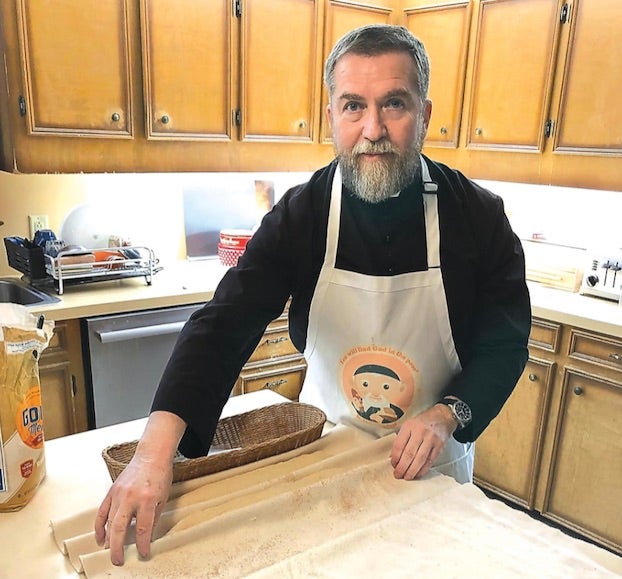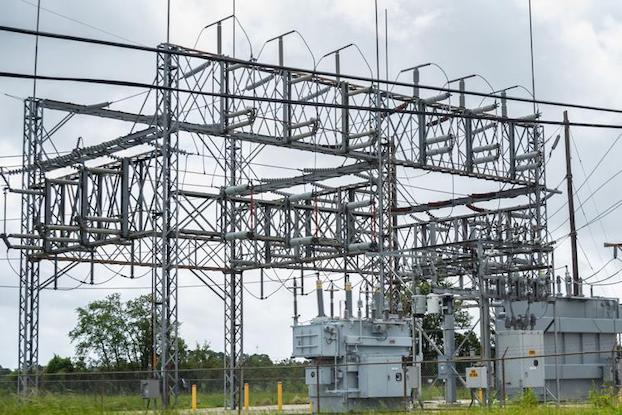Sulphur priest accomplished baker of bread
Published 6:30 am Wednesday, January 12, 2022

- The Rev. Edward Richard adjusts a cloth on which he will place baguettes. (Special to the American Press)
The Rev. Edward Richard has been cooking for most of his life. The DeQuincy native is pastor of Our Lady of Prompt Succor Church in Sulphur.
“I learned a great deal about cooking — many practical things, as well — at home, especially from my grandparents,” he said.
The cooking he enjoys most is done over a campfire.
“I’ve been doing that since I was a teenager,” he said. “I like to camp and I like to eat.”
Richard has an interest in the older methods of doing things, making useful tools, gardening ideas, do-it-yourself projects and things he remembers from childhood. However, he is relatively new at baking bread. Just ten months into the game, his results are impressive.
It started when he read an article in a pioneering and homesteading magazine about how to make a bread peel. A bread peel is a shovel-like tool used by bakers to load loaves of bread, pizzas, pastries and other baked goods into and out of an oven. It is usually made of wood, with a flat carrying surface for holding the baked goods and a handle extending from one side of that surface.
“I didn’t have an interest in making bread or a bread peel at the time or baguettes, the recipe included in the same article,” he said.
But as is often the case when reading a great recipe and seeing its results and for “a number of reasons over the ensuing months,” Richard began, through trial and error, to produce not just any bread but good, crusty bread, something that he said is hard to come by. He wasn’t alone in his craving. Other priests expressed willingness to sample his efforts.
“So, I embarked on the process of learning,” he said.
It took months for him to get to the point where he could produce consistently good baguettes. “Every little variable seemed to affect the outcome,” he said.
He described that first baguette recipe as “much oversimplified,” and discovered that “a number of things can go wrong when making baguettes in one’s own kitchen.”
“My first baguettes were edible, but not very aesthetically pleasing,” he said, “and the crumb was somewhat dense.”
Richard said most priests do a little cooking.
“I know of several who are excellent amateur chefs,” he said.
Bread is so essential, it takes on “epic status” in the Christian story of salvation, according to Richard.
“From the first priest in the scriptures, Melchizedek, who offers a sacrifice of bread and wine; to the manna in the story of Exodus; to the bread of the Passover and Last Supper, to the ‘daily’ bread in the ‘Our Father; to the Holy Eucharist, the body and blood of Jesus Christ. In the Church, bread becomes an expression of the power of God to bring us life, the material of some of the greatest mystery of God’s interaction with mankind,” Richard said.
When Richard deals with sourdough, wild yeast and bacteria, he can see why the Israelites in the Exodus were told to use unleavened bread.
“Jesus Christ, The Word made flesh, identifies himself as the ‘Living Bread’ giving eternal life. As a priest of the New Testament, I am unable to ignore the supreme gift God has bestowed upon us through bread.”
In addition to sharing the gospel, Richard shared some tips and a recipe for readers to try their hand at making their own good, crusty bread.
Richard said a properly mixed and formed dough can look just great, but once in the oven can “manifest characteristics that can leave a person trying to solve a mystery.” He stays within the range of recipe recommended temperatures and uses the yeast available from local grocers. He uses an oven like the one found in most homes. For the early part of the baking process, he uses a very hot cast iron skillet to provide steam.
“I have begun using a sourdough starter that was shared with me by another priest,” he said.
A couple of other priests in the diocese bake bread.
Preheat the oven to 550 degrees for an hour. For those with a bread stone: This stone can be placed on the middle rack in the oven before the oven begins to preheat. Once the oven is up to the desired temperature, allow the stone to heat in the oven for 20 minutes to allow it to come to the desired temperature. Reduce the oven temp to 470 when you put the baguettes in. Richard puts a cast-iron skillet in the oven on the lower rack. That will be used to pour water in and produce steam when the dough is put into the oven for baking. Richard pours 1 and 1/2 cups of water into the skillet.
“Use a grilling glove to cover your hand and arm,” he warned. “The steam will burn.”
Ingredients:
500 grams (2 cups) of unbleached bread flour
370 grams (1.56 cups) of water
2 1/4 teaspoon salt
Packet of yeast
“If I use a sourdough starter, I use an amount equal to 15 percent of the flour weight. This would make three baguettes of about 280 grams,” he said.
(Fifteen percent of 500 grams is 75 grams or 1/2 cup.)
“The recipe and the mixing of the ingredients is probably the least challenging thing about the whole process,” he said.
Next comes the mystery. Will it be what it was created to be?
Divide the dough into three equal pieces and pre-shape into balls. Let the dough “balls” rest for 20-30 minutes. Shape the balls into the final baguette form and allow to rest for 45 – 60 minutes before scoring and transferring to the hot oven. Remember to wear the grilling glove if the steam method is used.
Richard bakes his bread at 470 for 30 minutes for dark, crusty baguettes.





